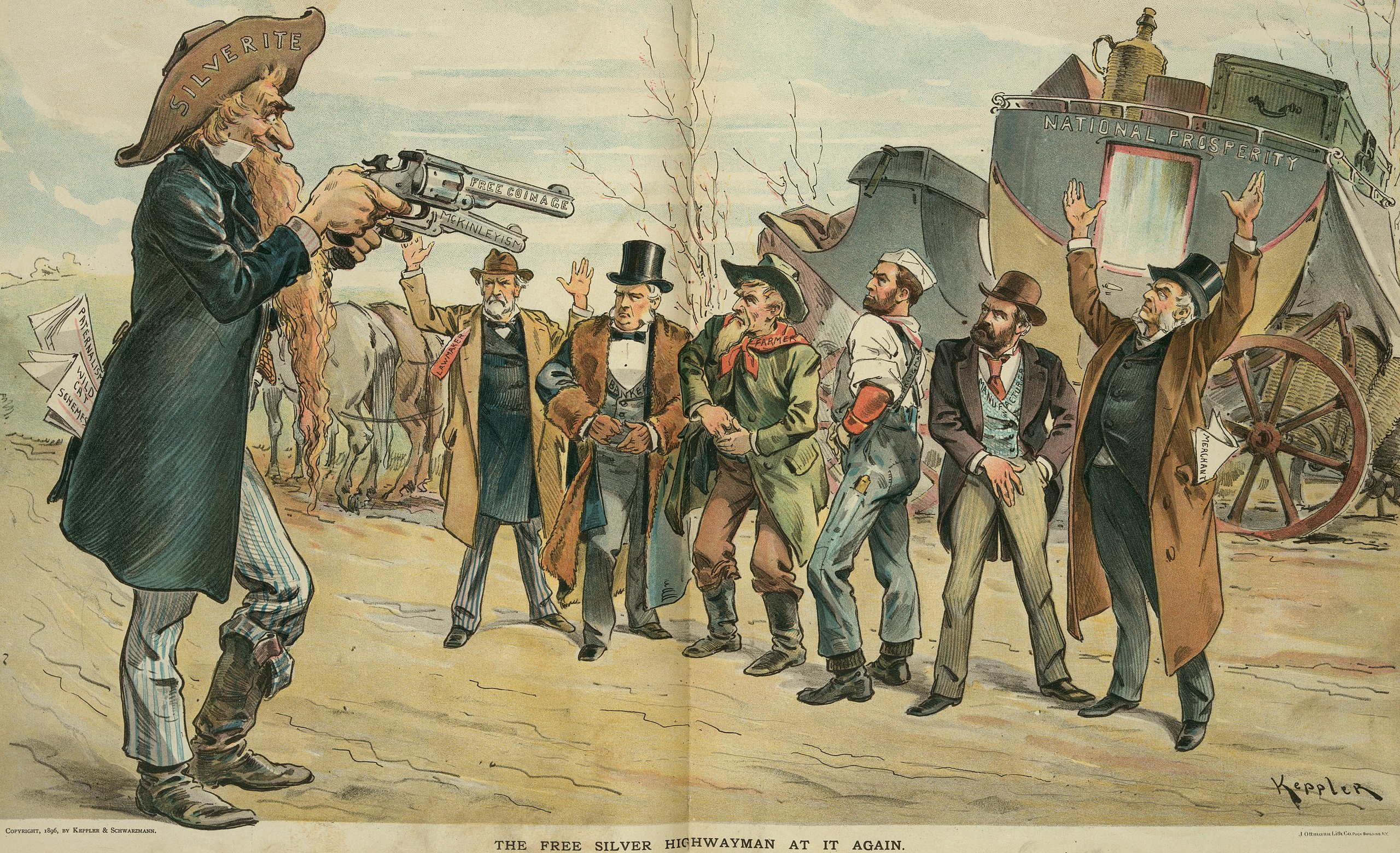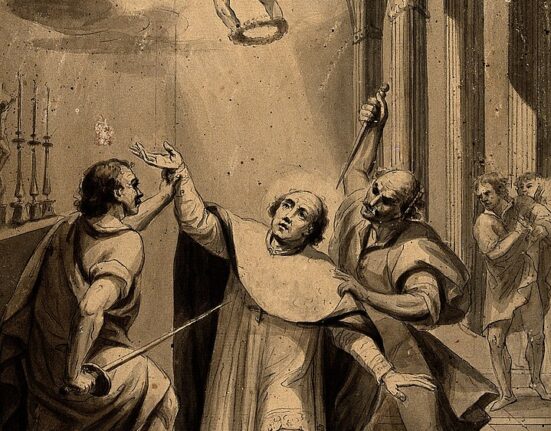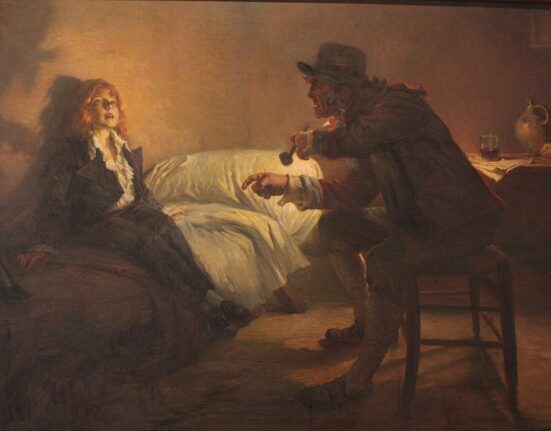From infamous gangsters like Al Capone, to notorious pirates like Edward “Blackbeard” Teach, there is something darkly fascinating about those criminally enterprising individuals who managed to make careers as outlaws and scoundrels. In this article, we’ll look at some of history’s most interesting criminals and their unique and dastardly legacies.
1. Black Bart
Few character archetypes are so intriguing as the gentleman thief; the noble Robin Hood who lives outside of the law but abides by his own moral compass. Sharing a name with one of the most notorious pirates in history, Bartholomew Roberts, the “Black Bart” who we will discuss in this section is famous for robbing Wells Fargo stagecoaches.
Charles E. Boles was an educated young man with a thirst for adventure. In 1849, he set out with a cousin to answer the enticing call of the Gold Rush in California. Like so many others, Charles hoped to make his fortune, but was ultimately unsuccessful and had to settle into a quiet life on the farm with his wife, Mary, in Illinois. Farm life didn’t suit Charles and he itched for new opportunities. The Civil War brought such an opportunity and Charles began a career as a Union soldier. The Civil War ended with Charles, alive and well, but still as eager to make his fortune as ever. Eventually, Charles E. Boles set out to prospect for gold once more. He would be discouraged, however, when men from Wells, Fargo & Company interfered with his mining operations.
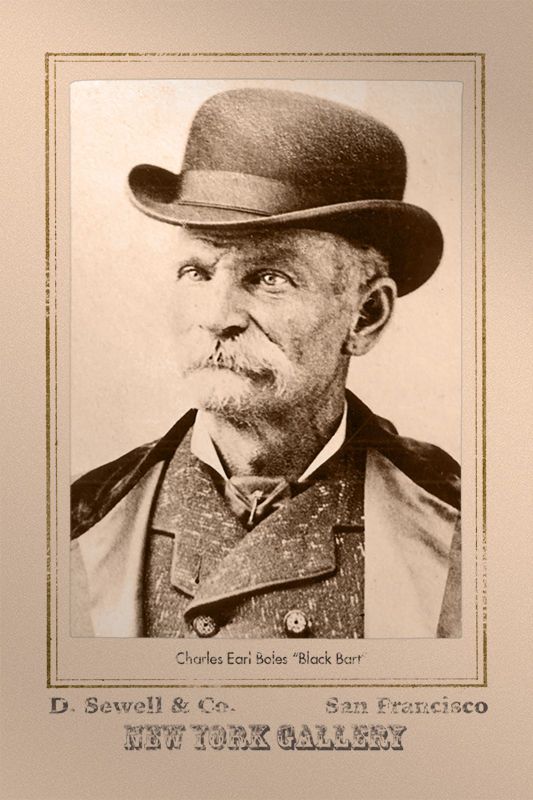
Charles E. Boles sought revenge against Wells Fargo for thwarting his mining operation. In 1871, he stopped writing back to his wife in Illinois, who assumed that he had died, and seemingly disappeared. He would not resurface again until 1875 when he robbed his first Wells Fargo stagecoach. Boles disguised his face and body with sacks of cloth and spoke politely to all of the passengers and stagecoach operators with whom he interacted.
Boles never stole from the passengers, he never cursed, and he never spoke coarsely to his victims. Thus began his reputation as a gentleman bandit; a romantic hero of sorts. This was heightened by the poetry which he left behind at the scenes of several robberies as well as the fact that he likely named himself “Black Bart” after a serialized story which ran in the Sacramento Union. Over the next eight years, Black Bart would commit dozens of stagecoach robberies. During this time, he never abandoned his revenge mission and he continued to target Wells Fargo coaches exclusively. The following is one of the poem’s Charles left at the scene of one of the robberies:
I’ve labored long and hard for bread,
Charles E. Boles
For honor, and for riches,
But on my corns too long you’ve tread,
You fine-haired sons of bitches.
Charles E. Boles’ crime spree ended when he left a handkerchief at the scene of a botched robbery. The handkerchief bore an identifying marker which tied it to a laundromat in San Francisco. From there, investigators were able to identify a boardinghouse in which Boles was staying. He was caught in 1883, but remarkably served just four years in San Quentin Prison. Upon release, Charles E. Boles supposedly swore off crime, citing his advanced age. Oddly, though, he disappeared shortly after his release and the hard facts surrounding how he spent his final years remain shrouded in mystery. For more about Black Bart’s life of crime, check out this article.
2. The Birdman of Alcatraz
Robert Franklin Stroud was originally incarcerated in 1909 at just eighteen years old for killing a man in a bar brawl. The man had allegedly failed to pay a prostitute named Kitty O’Brien, for whom Stroud acted as a “pimp.” The confrontation and subsequent killing resulted in a prison sentence for Stroud at McNeil Island Corrections Center in Washington. Not long after his incarceration, Stroud began to develop something of a reputation. He was violent and unpredictable, he stabbed another inmate, and his dangerous behavior eventually led to his relocation to Leavenworth Prison in Kansas. In 1916, Robert Stroud killed a guard named Andrew F. Turner at Leavenworth, in front of over a thousand witnesses. Robert Stroud was sentenced to death for this killing, but his sentence was commuted by president Woodrow Wilson to a life sentence to be served in solitary confinement.
Stroud’s solitary life sentence was the catalyst which ignited a surprising passion within the convicted killer. One day, Stroud encountered several nestling sparrows. With little else to occupy his time, he nursed the birds to health. This experience was the beginning of a strange career behind bars. From this point forward, Stroud was allowed to keep, breed, raise, and study hundreds of birds, most being canaries, within his cell at Leavenworth. This is how he became known as the “Birdman.”
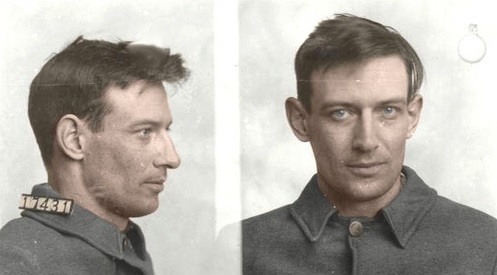
In his twenty years of incarceration at Leavenworth, Stroud wrote two books, including one entitled Diseases of Canaries. This 1933 book is often credited as developing a remedy for hemorrhagic septicemia in canaries. The treatments that Stroud developed are not thought of as best practices today, but they made waves in aviculture communities at the time. Stroud became a popular and sympathetic inmate within these communities. His work was so popular that Leavenworth had to employ a full-time secretary to manage his inbound and outbound mail. This, combined with the fact that Stroud’s cell was full of free-flying birds, making it a sanitary nightmare for the prison, led Leavenworth to push to have Stroud relocated. To try and prevent this, Stroud married an avian researcher named Della Mae Jones. The pair hoped that their marriage would force Leavenworth to give up on relocating Stroud. In time, though, it was discovered that some of Stroud’s equipment was being used to distill alcohol. Stroud had vastly overestimated what he could get away with at Leavenworth.
In 1942, Robert Stroud was transferred to Alcatraz Island in San Francisco, California. This is why he is known, to this day, as the “Birdman of Alcatraz.” Despite this, he was not allowed to bring his birds with him. In Alcatraz, Stroud was diagnosed by a prison psychiatrist as a psychopath with a high IQ. Rumors swirled regarding his behavior behind bars. Despite the lack of birds, the mystique of the “Birdman” only grew. Stroud wrote two books while imprisoned in Alcatraz, although he was never allowed to publish them. In 1963, Robert Franklin Stroud died in Alcatraz’s prison hospital. He was 73 years old. For a deeper look at Stroud’s story, check out this article.
3. Samuel “Black Sam” Bellamy
Samuel “Black Sam” Bellamy was a man who inspired an unusual amount of admiration and loyalty in the men who sailed under his command. Known as the “Prince of Pirates,” and the “Robin Hood of the Sea,” Bellamy was beloved for the democratic ways in which he commanded his crew and distributed their earnings. A formal man of the Royal Navy, Samuel Bellamy turned to piracy after arriving in the New World and beginning to seek his fortune as a treasure hunter. Legends state that Bellamy fell in love with a woman named Maria Hallett in Cape Cod and that the two had a child, but details regarding this are murky.
Bellamy and his friend and fellow treasure-hunter, Palgraves Williams, joined the crew of Benjamin Hornigold when their treasure-seeking exploits yielded no fruit. As we previously discussed, Sam Bellamy and Palgraves Williams were dissatisfied with Hornigold and teach’s leadership. After gaining significant popularity with the Hornigold’s crew, Bellamy staged a mutiny and took the Marianne as his own flagship.
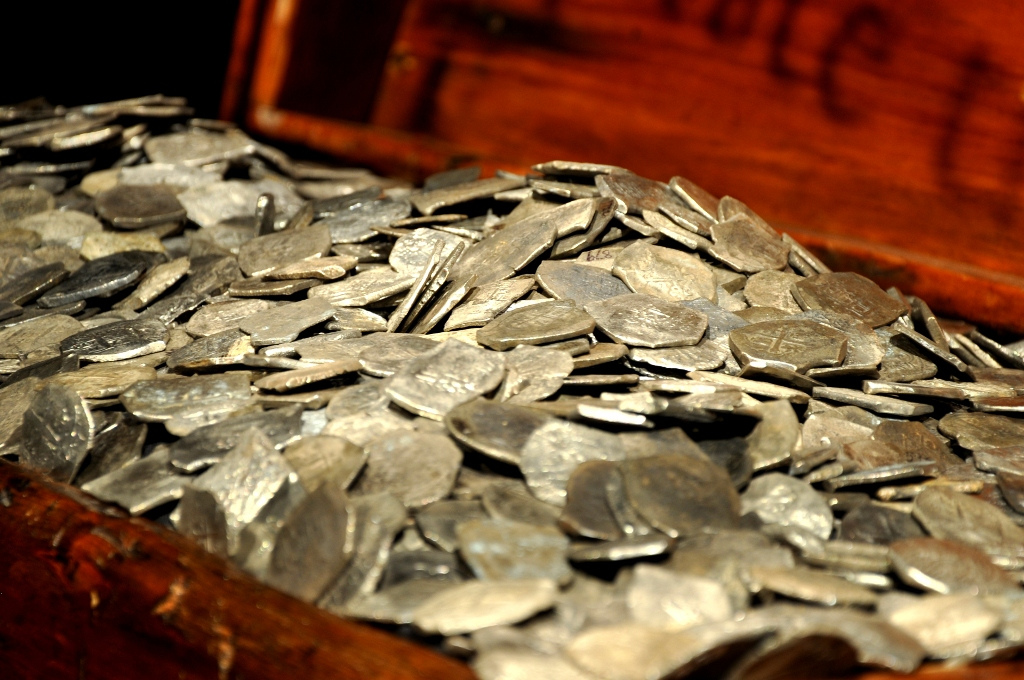
In the months that followed, Samuel Bellamy would capture more than fifty vessels. In such a short time, Black Sam became one of the richest pirates in history as well as one of the most successful. He also began to acquire a reputation as a “gentleman pirate.” Bellamy was not needlessly ruthless and would never harm a foe who had surrendered. He expressed disdain for the wealthy and saw piracy as no more ignoble than the greedy behavior of the noble class.
In 1717, Samuel Bellamy achieved a career high. He captured the state-of-the-art slave ship, the Whydah Gally. The Wydah Gally was laden with treasures enough to inspire Bellamy to return to Cape Cod and retire from piracy for good. He even gave the Wydah Gally’s captain his own flagship, the Sultana, as a gesture of goodwill. But, before Black Sam could ever reach dry land again, the Wydah Gally was caught in a storm and sank, taking Bellamy, his crew, and his incredible treasures with it.
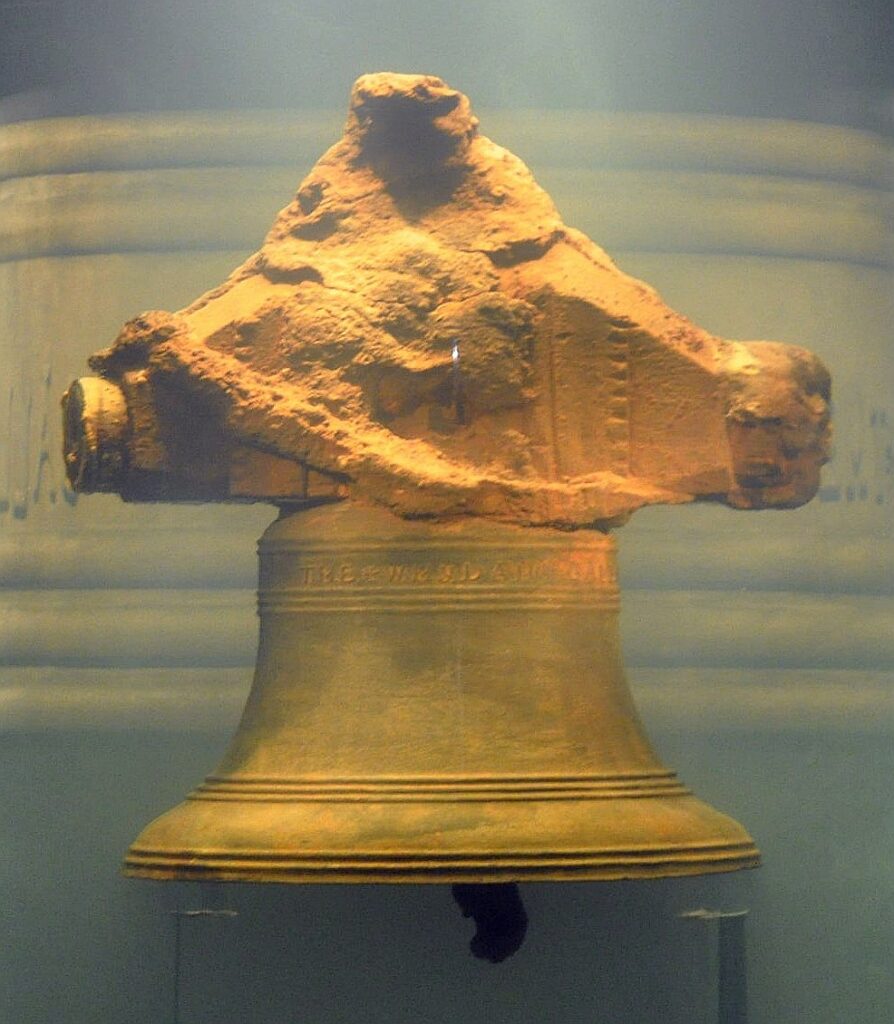
In 1984 the wreck of the Whydah Gally was found off the coast of Wellfleet in Cape Cod by a team of undersea explorers. It is the only confirmed pirate shipwreck ever to be recovered. Skeletons of pirate crewmen were found onboard along with piles of treasure. Legend states, though, that much of Samuel Bellamy’s true treasure remains undiscovered in a hidden pirate fort somewhere in New England. For a more detailed account of the life of Samuel Bellamy, check out this article.
4. Elmer McCurdy
Elmer McCurdy was born in 1880. His mother was an unmarried teenager and Elmer was raised by his aunt and uncle for a time. Eventually, though, the truth of his parentage came out and Elmer found it deeply troubling. He grew rebellious and difficult. He took to wandering from state to state, taking on a variety of jobs and barely managing to stay out of serious trouble. In 1907, though, McCurdy made a major change. He joined the army. Stationed at Fort Leavenworth in Kansas, McCurdy became familiar with explosives like nitroglycerin. With this newfound, but still quite limited, experience under his belt, McCurdy was honorably discharged form the army and began searching for ways to put it to use. In 1911, Elmer was arrested, along with an old army buddy, for possessing a number of incriminating tools including nitroglycerin, hacksaws, gunpowder, and money sacks.
McCurdy managed to avoid a conviction, however from this point on, he and a group of accomplices began using nitroglycerin to rob a number of trains and banks. Elmer’s gang were not the most talented criminal minds. Over the course of their career, McCurdy miscalculated the explosive charge necessary to break into a vault, leading to the crew scraping the melted silver off of the walls instead of busting in and stealing it. On another occasion, McCurdy managed to destroy everything but the safe that he and the gang needed to enter. Instead, they stole a handful of cash from the banker’s tray. On yet another occasion, Elmer and company staged a robbery of a train laden with cash, only to mistakenly rob the wrong train, escaping with only the money that the passengers of the train had on their persons. During this last escapade, a drunken shootout occurred. Elmer McCurdy was shot and killed. Remarkably, though, there is much more to his story.
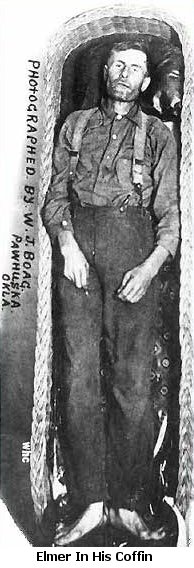
Because nobody claimed his body, Elmer McCurdy was embalmed and kept by the proprietor of the funeral home to which his body was sent. The mortician displayed him as “The Bandit Who Wouldn’t Give Up” and charged admission to morbidly curious onlookers. This went on for a while until a pair of men claiming to be McCurdy’s relatives took the body. The men were, in actuality, carnies. They used McCurdy’s embalmed corpse in a variety of Wild West themed shows and attractions until they eventually defaulted on a loan and gave him as collateral to the owner of a traveling “Museum of Crime.” In the years that followed, McCurdy’s preserved cadaver was painted in garish neon colors, used as a prop, and mixed with a bunch of wax figures and mannequins. Eventually, nobody even knew or remembered that he had once been alive.
This went on until 1977 when the crew of The Six Million Dollar Man tried to pose a mannequin within the funhouse where they were meant to be shooting a scene. The mannequin’s arm snapped off, revealing human bones beneath its neon-painted skin. In his mouth, a few tickets to the Museum of Crime were found along with a penny from 1924. The “mannequin” was identified as the body of Elmer McCurdy who had been dead for 65 years. Check out this article to learn more about this bizarre story.
